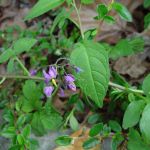| Common Name: |
Deadly Nightshade |
| Other Names: |
Bittersweet, Woody Nightshade |
| Botanical Name: |
Solanum dulcamara |
| Genus: |
Solanum |
| Family: |
Solanaceae |
| Native Location: |
Eurasia; naturalized in N America. |
| Cultivation: |
Dry to wet, neutral to alkaline soil in sun or shade. Thin out or cut back in spring. Subject to statutory control as a weed in parts of Australia. |
| Propagation: |
By seed sown in spring (species only); by semi-ripe cuttings in summer. |
| Harvest: |
Stems 2-3 years old are cut in spring, or after the leaves have fallen in autumn. Roots are lifted in autumn and peeled. Both are dried for infusions, liquid extracts, and ointments. |
| Height: |
4m (12ft) |
| Width: |
Indefinite. |
| Variations: |
Variegatum
Has creamy white-variegated foliage |
|
| Hardiness: |
Z6-8 |
| Parts Used: |
Stems, root bark. |
| Properties: |
An astringent, cooling herb with a bitter, then sweet, taste. It lowers fever, and has diuretic, expectorant, sedative, alterative, and anti-rheumatic effects. |
| Medicinal Uses: |
Internally for skin diseases, bronchial congestion, rheumatism, jaundice, and ulcerative colitis. Externally for skin eruptions, ulcers, rheumatism, and cellulite. |
| Warning: |
All parts, especially leaves and unripe berries, are toxic if eaten.
Excess paralyzes the central nervous system, slows heart and respiration, and lowers temperature, causing vertigo, delirium, convulsions, and death.
For use by qualified practioners only. |
| Bibliography: |
Encyclopedia of Herbs by Deni Brown Copyright © 1995, 2001 Dorling Kindersley Limited. pp 371 |
